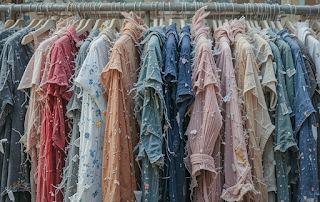The Ultimate Guide to Thrift Shopping & Secondhand Fashion
Table of Contents
1. Introduction
2. Why Thrift Shopping is Eco-Friendly
3. How Thrifting Reduces Fashion Waste
4. Top Benefits of Buying Secondhand Clothes
5. How to Thrift Shop Like a Pro
6. Best Places to Thrift Shop (Online & Offline)
7. How to Clean and Care for Secondhand Clothes
8. Common Thrifting Myths Debunked
9. Final Thoughts: Join the Secondhand Movement
---
Introduction
In a world dominated by fast fashion, thrift shopping has emerged as a sustainable and budget-friendly alternative. Not only does buying secondhand clothing reduce waste, but it also allows you to discover unique, high-quality pieces without breaking the bank.
Whether you're a thrifting newbie or a seasoned bargain hunter, this guide will help you navigate the world of secondhand fashion while making a positive impact on the planet.
---
Why Thrift Shopping is Eco-Friendly
The fashion industry is one of the biggest polluters globally, contributing to:
- 10% of global carbon emissions (more than aviation and shipping combined).
- 20% of wastewater from toxic textile dyeing.
- 92 million tons of textile waste dumped in landfills yearly.
By choosing thrifted clothes, you:
✅ Reduce demand for new clothing production
✅ Lower carbon footprint (no new resources needed)
✅ Keep clothes out of landfills
✅ Support a circular economy
---
How Thrifting Reduces Fashion Waste
Fast fashion brands encourage disposable clothing, leading to:
- Overproduction (billions of unsold garments are burned yearly).
- Poor-quality fabrics that wear out quickly.
- Exploitative labor practices in low-wage countries.
Thrifting helps combat this by:
♻️ Extending the life cycle of clothing
♻️ Reducing textile waste
♻️ Encouraging mindful consumption
---
Top Benefits of Buying Secondhand Clothes
1. Saves Money
- Designer brands at a fraction of retail prices.
- Vintage and rare finds you won’t see in stores.
2. Unique Style
- One-of-a-kind pieces instead of mass-produced trends.
- Retro, vintage, and timeless fashion.
3. Better Quality
- Older clothes were often made with sturdier fabrics.
- Less polyester, more natural fibers like cotton and wool.
4. Ethical Shopping 🛍️
- No support for sweatshops or harmful manufacturing.
- Supports local charities and small businesses.
---
How to Thrift Shop Like a Pro
1. Have a Game Plan
- Know your size (vintage sizing differs from modern).
- Make a list of needed items to avoid impulse buys.
2. Inspect Items Carefully
- Check for stains, holes, and broken zippers.
- Smell test (some odors are hard to remove).
3. Shop Off-Season
- Winter coats in summer, swimsuits in winter = better deals.
4. Try Everything On
- Sizing varies, especially with vintage clothing.
5. Visit Often
- New stock arrives daily, so frequent visits yield the best finds.
---
Best Places to Thrift Shop (Online & Offline)
In-Person Thrift Stores:
- Goodwill, Salvation Army, Savers (budget-friendly).
- Local charity shops (supports community causes).
- Vintage boutiques (curated, higher-end secondhand).
Online Thrifting Platforms:
- ThredUp (largest online thrift store).
- Poshmark & Depop (resale apps for trendy finds).
- eBay & Etsy (great for vintage and rare items).
---
How to Clean and Care for Secondhand Clothes
Before wearing, always:
1. Wash in hot water (or use a disinfectant spray).
2. Soak in vinegar (removes odors naturally).
3. Check for moths (store woolens with cedar blocks).
4. Repair minor flaws (sew loose buttons, patch small holes).
---
Common Thrifting Myths Debunked
❌ "Thrift stores are dirty." → Most items are washed before sale.
❌ "Only poor people thrift." → Many eco-conscious shoppers thrift to reduce waste.
❌ You can’t find good quality. → Many high-end brands end up in thrift stores.
---
Final Thoughts: Join the Secondhand Movement
Thrifting isn’t just a trend—it’s a sustainable lifestyle choice that benefits your wallet and the planet. By choosing secondhand fashion, you help reduce waste, support ethical consumption, and cultivate a unique personal style.
Ready to start?
Visit a local thrift store or browse online resale platforms today!
---




No comments:
Post a Comment